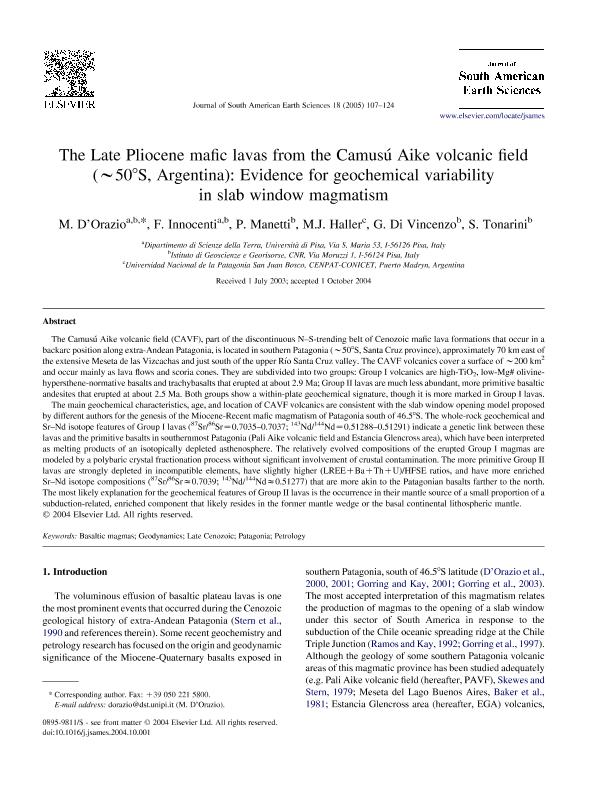Mostrar el registro sencillo del ítem
dc.contributor.author
D'Orazio, M.
dc.contributor.author
Innocenti, F.
dc.contributor.author
Manetti, Pablo Luis

dc.contributor.author
Haller, Miguel Jorge F.

dc.contributor.author
Di Vincenzo, G.
dc.contributor.author
Tonarini, S.
dc.date.available
2020-05-18T18:01:22Z
dc.date.issued
2005-01
dc.identifier.citation
D'Orazio, M.; Innocenti, F.; Manetti, Pablo Luis; Haller, Miguel Jorge F.; Di Vincenzo, G. ; et al.; The Late Pliocene mafic lavas from the Camusú Aike volcanic field (∼50°S, Argentina): Evidence for geochemical variability in slab window magmatism; Pergamon-Elsevier Science Ltd; Journal of South American Earth Sciences; 18; 2; 1-2005; 107-124
dc.identifier.issn
0895-9811
dc.identifier.uri
http://hdl.handle.net/11336/105359
dc.description.abstract
The Camusu Aike volcanic field (CAVF), part of the discontinuous N–S-trending belt of Cenozoic mafic lava formations that occur in a backarc position along extra-Andean Patagonia, is located in southern Patagonia (w508S, Santa Cruz province), approximately 70 km east of the extensive Meseta de las Vizcachas and just south of the upper Rio Santa Cruz valley. The CAVF volcanics cover a surface of ~ 200 km2 and occur mainly as lava flows and scoria cones. They are subdivided into two groups: Group I volcanics are high-TiO2, low-Mg# olivine-hypersthene-normative basalts and trachybasalts that erupted at about 2.9 Ma; Group II lavas are much less abundant, more primitive basaltic andesites that erupted at about 2.5 Ma. Both groups show a within-plate geochemical signature, though it is more marked in Group I lavas. The main geochemical characteristics, age, and location of CAVF volcanics are consistent with the slab window opening model proposed by different authors for the genesis of the Miocene-Recent mafic magmatism of Patagonia south of 46.58S. The whole-rock geochemical and Sr–Nd isotope features of Group I lavas (87Sr/86Sr=0.7035–0.7037; 143Nd/144Nd=0.51288–0.51291) indicate a genetic link between these lavas and the primitive basalts in southernmost Patagonia (Pali Aike volcanic field and Estancia Glencross area), which have been interpreted as melting products of an isotopically depleted asthenosphere. The relatively evolved compositions of the erupted Group I magmas are modeled by a polybaric crystal fractionation process without significant involvement of crustal contamination. The more primitive Group II lavas are strongly depleted in incompatible elements, have slightly higher (LREE+Ba+Th+U)/HFSE ratios, and have more enriched Sr–Nd isotope compositions (87Sr/86Sr=0.7039; 143Nd/144Nd=0.51277) that are more akin to the Patagonian basalts farther to the north. The most likely explanation for the geochemical features of Group II lavas is the occurrence in their mantle source of a small proportion of a subduction-related, enriched component that likely resides in the former mantle wedge or the basal continental lithospheric mantle. w508S, Santa Cruz province), approximately 70 km east of the extensive Meseta de las Vizcachas and just south of the upper Rio Santa Cruz valley. The CAVF volcanics cover a surface of ~ 200 km2 and occur mainly as lava flows and scoria cones. They are subdivided into two groups: Group I volcanics are high-TiO2, low-Mg# olivine-hypersthene-normative basalts and trachybasalts that erupted at about 2.9 Ma; Group II lavas are much less abundant, more primitive basaltic andesites that erupted at about 2.5 Ma. Both groups show a within-plate geochemical signature, though it is more marked in Group I lavas. The main geochemical characteristics, age, and location of CAVF volcanics are consistent with the slab window opening model proposed by different authors for the genesis of the Miocene-Recent mafic magmatism of Patagonia south of 46.58S. The whole-rock geochemical and Sr–Nd isotope features of Group I lavas (87Sr/86Sr=0.7035–0.7037; 143Nd/144Nd=0.51288–0.51291) indicate a genetic link between these lavas and the primitive basalts in southernmost Patagonia (Pali Aike volcanic field and Estancia Glencross area), which have been interpreted as melting products of an isotopically depleted asthenosphere. The relatively evolved compositions of the erupted Group I magmas are modeled by a polybaric crystal fractionation process without significant involvement of crustal contamination. The more primitive Group II lavas are strongly depleted in incompatible elements, have slightly higher (LREE+Ba+Th+U)/HFSE ratios, and have more enriched Sr–Nd isotope compositions (87Sr/86Sr=0.7039; 143Nd/144Nd=0.51277) that are more akin to the Patagonian basalts farther to the north. The most likely explanation for the geochemical features of Group II lavas is the occurrence in their mantle source of a small proportion of a subduction-related, enriched component that likely resides in the former mantle wedge or the basal continental lithospheric mantle.
dc.format
application/pdf
dc.language.iso
eng
dc.publisher
Pergamon-Elsevier Science Ltd

dc.rights
info:eu-repo/semantics/openAccess
dc.rights.uri
https://creativecommons.org/licenses/by-nc-sa/2.5/ar/
dc.subject
BASALTIC MAGMAS
dc.subject
GEODYNAMICS
dc.subject
LATE CENOZOIC
dc.subject
PATAGONIA
dc.subject
PETROLOGY
dc.subject.classification
Geología

dc.subject.classification
Ciencias de la Tierra y relacionadas con el Medio Ambiente

dc.subject.classification
CIENCIAS NATURALES Y EXACTAS

dc.title
The Late Pliocene mafic lavas from the Camusú Aike volcanic field (∼50°S, Argentina): Evidence for geochemical variability in slab window magmatism
dc.type
info:eu-repo/semantics/article
dc.type
info:ar-repo/semantics/artículo
dc.type
info:eu-repo/semantics/publishedVersion
dc.date.updated
2020-05-05T14:10:15Z
dc.journal.volume
18
dc.journal.number
2
dc.journal.pagination
107-124
dc.journal.pais
Estados Unidos

dc.description.fil
Fil: D'Orazio, M.. Universita Degli Studi Di Pisa. Dipartimento Di Scienze Della Terra; Italia. Istituto di Geoscienze e Georisorse; Italia
dc.description.fil
Fil: Innocenti, F.. Istituto di Geoscienze e Georisorse; Italia. Universita Degli Studi Di Pisa. Dipartimento Di Scienze Della Terra; Italia
dc.description.fil
Fil: Manetti, Pablo Luis. Istituto di Geoscienze e Georisorse; Italia
dc.description.fil
Fil: Haller, Miguel Jorge F.. Consejo Nacional de Investigaciones Científicas y Técnicas. Centro Científico Tecnológico Conicet - Centro Nacional Patagónico; Argentina
dc.description.fil
Fil: Di Vincenzo, G.. Istituto di Geoscienze e Georisorse; Italia
dc.description.fil
Fil: Tonarini, S.. Istituto di Geoscienze e Georisorse; Italia
dc.journal.title
Journal of South American Earth Sciences

dc.relation.alternativeid
info:eu-repo/semantics/altIdentifier/doi/http://dx.doi.org/10.1016/j.jsames.2004.10.001
dc.relation.alternativeid
info:eu-repo/semantics/altIdentifier/url/https://www.sciencedirect.com/science/article/abs/pii/S089598110400104X
Archivos asociados
